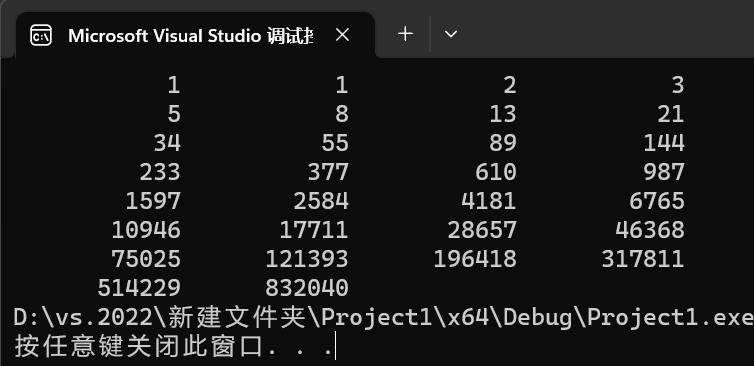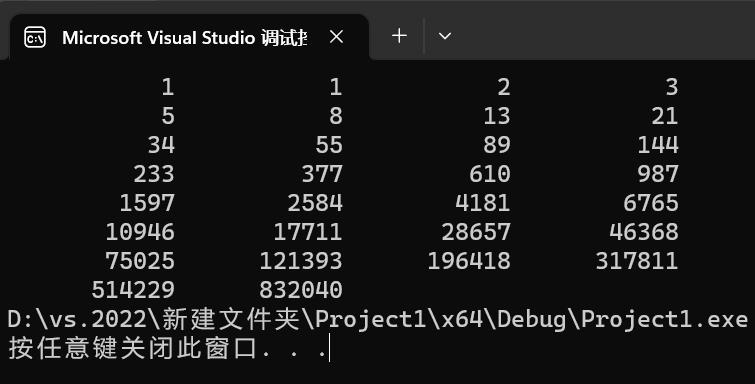兔子产子问题
Posted zk126
tags:
篇首语:本文由小常识网(cha138.com)小编为大家整理,主要介绍了兔子产子问题相关的知识,希望对你有一定的参考价值。
一、问题描述
有一对兔子,从出生后的第3个月起每个月都生一对兔子。小兔子长到第3个月后每个月又生一对兔子,假设所有的兔子都不死,问30个月内每个月的兔子总数为多少?
二、解题思路
经过分析,这是一到典型的斐波那契额数列问题,可以由迭代来解决问题。
改题目是典型的迭代循环,即是一个不断用新值取代变量的旧值,然后用变量旧值递推出变量新值的过程。这种迭代与以下几种因素有关:初值,迭代公式,迭代次数。
此问题算法可分解为
1、迭代公式:f(n+2)=f(n+1)+f(n)。
2、初值:f(1)=1,f(2)=1。
3、循环次数:循环次数由循环变量控制。
三、代码实现


#include<iostream> using namespace std; int main() int a = 1, b = 1, c; printf("%12d%12d", a, b); for (int i = 3; i <= 30; i++) c = a + b; printf("%12d", c); if (i % 4 == 0) printf("\\n"); a = b; b = c; return 0;
运行结果:

四、代码改进
以上代码是用三个变量来维护整个迭代过程,其实可以在一个循环中求出后两个值,那样就可以用两个变量来维护这个迭代过程,循环次数也直接少了一半。
在循环中,可以将a看为前面一个变量,b看为后面一个变量。a(第三项)用a(第一项)+b(第二项)来更新,b(第四项)用更新完的a(第三项)和b(第二项)来更新。
代码实现:


#include<iostream> using namespace std; int main() int a = 1, b = 1; for (int i = 1; i <= 15; i++) printf("%12d%12d", a, b); a = a + b; b = a + b; if (i % 2 == 0) printf("\\n"); return 0;
运行结果:

103.兔子产子(菲波那契数列)
#include<stdio.h>
void main()
int n,i,j,un1,un2,un;
clrscr();
puts("********************************************************");
puts("* This is a program to Calculate Rabbits Numbers. *");
puts("* There is a rabbit couple procreats 2 rabbits 1 month,*");
puts("* and the young rabbits group and can procreats in the *");
puts("* end of the second month. In this way,how many rabbits*");
puts("* are there after n generations? *");
puts("********************************************************");
for(n=2;n<3;)
printf(" >> Please input number of generations (n>2): ");
scanf("%d",&n);
if(n<3) printf("\\n >> Input error!\\n"); /*控制输入正确的N值*/
un=un2=1;
printf(" >> The numbers of rabbits in first %d generation are as follows:\\n",n);
printf(" l\\t l\\t");
for(i=3,j=0;i<=n;i++)
un1=un2;
un2=un;
un=un1+un2; /*利用通项公式求解N项的值*/
printf( i%8?" %d\\t":"%d\\n",un);
printf("\\n");
printf("\\n Press any key to quit...");
getch();
以上是关于兔子产子问题的主要内容,如果未能解决你的问题,请参考以下文章